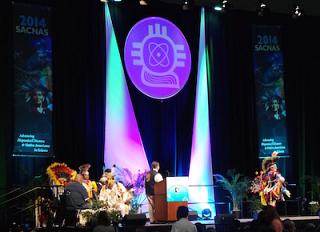
Author: Natalie Dicou
The advice was already paying dividends. Leading up to the 2017 SACNAS conference, Abigail Lacanlale Pajulas, a kinesiology student at California State Northridge, was told she should make business cards. Though she’s still an undergrad, Pajulas figured it’s never too early to start marketing herself so she showed up in Salt Lake City with a fresh stack of cards in her pocket. Within a few hours, she was divvying them out with the confidence of a corner-office veteran.
“I try to make sure I sit with people I don’t know, and I ended up sitting next to a guy who reviews applications for the National Science Foundation,” Pajulas said on the first day of the Society for Advancement of Chicanos and Native Americans in Science conference. “He said he might review my CV tomorrow and give me some tips and pointers.”
Here: take my card.
It was an early sign for Pajulas that opportunities for shoulder-rubbing would be as promising as advertised at the national STEM diversity conference held Oct. 19-21 at the Salt Palace Convention Center. The mission of the conference echos University of Utah's commitment to diversity and inclusion. Accordingly, the U was a platinum-level sponsor, and over 30 student and faculty speakers came from departments and programs across campus.
The event brought together more than 3,500 established and up-and-coming scientists from across the U.S. and featured more than 1,000 student research presentations.
“I’m excited to let people know that I’m excited about research,” said Pajulas who would soon be presenting her microbiology findings for the first time.
Beyond sharing research, the SACNAS conference was about celebrating different cultures. A powwow was held Friday, and indigenous art and jewelry were on display throughout the event.
“We must stand tall, we must raise our voice and we must tell our story,” SACNAS executive director Antonia O. Franco, Ed.D., told conference attendees during a lunchtime speech, eliciting applause.
When they weren’t perusing research and making connections, conference participants had the chance to choose from more than 100 professional and leadership development sessions where they delved into everything from how to win grants to understanding the ethical implications of research with indigenous communities. Sessions were designed to help attendees determine why they didn’t get into grad school and how to increase their odds of acceptance in the next round; whether the MD-PhD path is right for them; and how to respond to workplace hostility such as sexual harassment.
“Earlier today, we went to a women in STEM meeting and got to hear from minority women at different stages of their careers,” said Adams State University student Karina Duarte who plans to work in global public health. “As someone who’s going to start that career path pretty soon, I think it’s helpful to get tips from people who have been in the industry awhile. As a woman, you have to be assertive. Always know your place. Always speak your voice and be heard.”
The next national SACNAS conference will be held in San Antonio, Texas, October 11-13 2018.
According to the organization, “SACNAS is an inclusive organization dedicated to fostering the success of Chicano/Hispanic and Native American scientists, from college students to professionals, in attaining advanced degrees, careers and positions of leadership.” The University of Utah has two local SACNAS chapters. Contact Claudio Villanueva for more information at villanueva@biochem.utah.edu.
###
